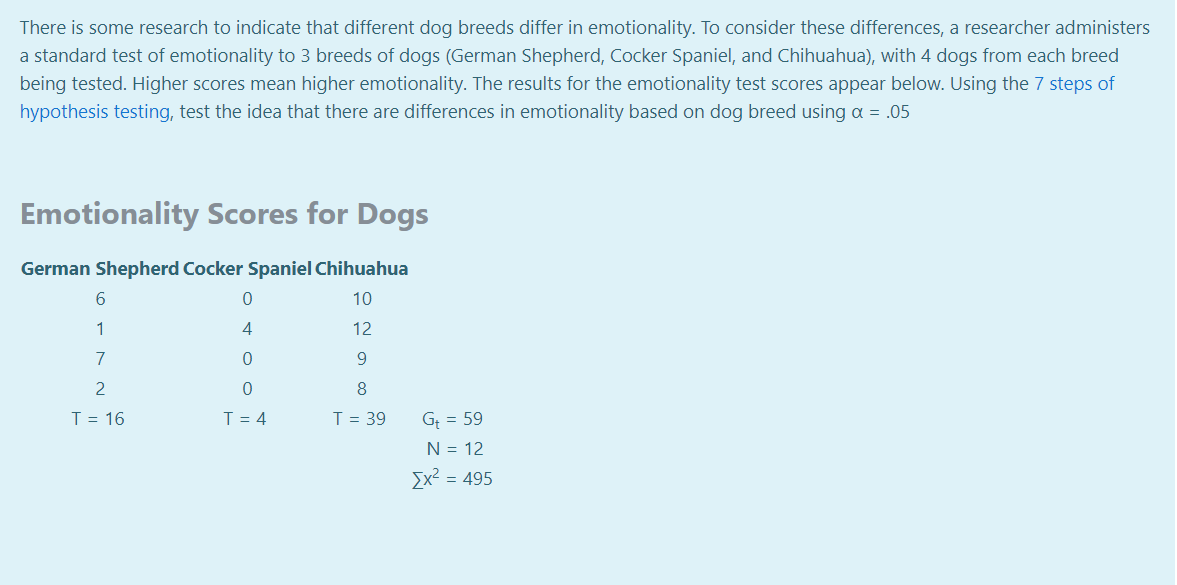Question In Images: Using the Emotionality scores for the Dog Breeds, and the 7 steps of Hypothesis testing, test the idea that there are differences in emotionality based on dog breed using α = .05. 1. State Hypothesis in Words 2. State your Statistical Hypotheses 3. α 4. Decision Rule (Be sure to include your critical value) 5. Do your calculations 6. Make your decision 7. State your results in a sentence. Report your results in APA style including a measure of effect size. Be sure to include descriptive statistics (M).
Question In Images:
Using the Emotionality scores for the Dog Breeds, and the 7 steps of Hypothesis testing, test the idea that there are differences in emotionality based on dog breed using α = .05.
1. State Hypothesis in Words
2. State your Statistical Hypotheses
3. α
4. Decision Rule (Be sure to include your critical value)
5. Do your calculations
6. Make your decision
7. State your results in a sentence. Report your results in APA style including a measure of effect size. Be sure to include
8. Given your decision in #7, would the researcher want to continue with posttests (such as Tukey or Scheffe) to determine where differences exist? Why or why not? You do not need to do the posttest for this question, just describe whether it would be appropriate to continue with posttests. Why or why not?

Trending now
This is a popular solution!
Step by step
Solved in 3 steps

There is some research to indicate that different dog breeds differ in emotionality. To consider these differences, a researcher administers a standard test of emotionality to 3 breeds of dogs (German Shepherd, Cocker Spaniel, and Chihuahua), with 4 dogs from each breed being tested. Higher scores mean higher emotionality. The results for the emotionality test scores appear below. Using the 7 steps of hypothesis testing, test the idea that there are differences in emotionality based on dog breed using α = .05
Emotionality Scores for Dogs
| German Shepherd | Cocker Spaniel | Chihuahua | |
|---|---|---|---|
| 6 | 0 | 10 | |
| 1 | 4 | 12 | |
| 7 | 0 | 9 | |
| 2 | 0 | 8 | |
| T = 16 | T = 4 | T = 39 | Gt = 59 |
| N = 12 | |||
| ∑x2 = 495 |
4. Decision Rule (Be sure to include your critical value)
5. Do your calculations
6. Make your decision
7. State your results in a sentence. Report your results in APA style including a measure of effect size. Be sure to include
8. Given your decision in #7, would the researcher want to continue with posttests (such as Tukey or Scheffe) to determine where differences exist? Why or why not? You do not need to do the posttest for this question, just describe whether it would be appropriate to continue with posttests. Why or why not?
4. Decision Rule (Be sure to include your critical value)
5. Do your calculations
6. Make your decision
7. State your results in a sentence. Report your results in APA style including a measure of effect size. Be sure to include
8. Given your decision in #7, would the researcher want to continue with posttests (such as Tukey or Scheffe) to determine where differences exist? Why or why not? You do not need to do the posttest for this question, just describe whether it would be appropriate to continue with posttests. Why or why not?






